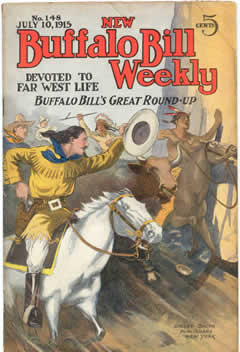Buffalo Bill Collectibles
Old things having to do with cowboys and America's wild west have remained one of the hottest antique collecting categories for some twenty years. Considering the popularity of book, theatre and TV westerns it is a phenomenon easy to understand. While John Wayne, Clint Eastwood, Roy Rogers and Gene Autry are synonymous with the 20th century image of the cowboy, from 1870 up until about 1910 no one personified that image quite like the flamboyant showman and real life western hero, William F. Cody.
In addition to falling under the category of western collectibles and classic Americana, Buffalo Bill ephemera (antiques that were originally meant to be discarded after usage) hold special interest because the various souvenirs, pamphlets, etc. were distributed widely in their day and are still somewhat available. Additionally, compared to other western icons like Custer, Annie Oakley, Sitting Bull and famous outlaws like Jesse James; Cody antiques are vastly under-valued.
For this, I thank that prolific group of Americans intent on rewriting history to lean toward a political bend. While I can't recall the specific movies books or programs, in recent years I believe William Cody has been demonized as a heartless egomaniac who made his reputation shooting Buffalos from trains for sport and to wipe out Plains Indians' food supply. Buffalo Bill did earn his nickname for that variety of marksmanship. And he did fight gallantly in the Indian campaigns. However, his salaried occupation was not to starve people but to feed them.
At only 14, Will excelled in his first job as a Pony Express Rider. His next position was that of scout and soldier with the Kansas Calvary in the Civil War. Then, at age twenty, from 1867-1868, the food contractors of the Kansas-Pacific railroad hired him as a professional hunter. Sadly for some 4000+ buffalo and consequently the Sioux and other Native Nations, he also performed that job with adroit skill.
Around 1869, dime store novelist Ned Buntline, also known as Colonial Judson discovered a new character with a name and reputation colorful enough for his exaggerated stories. "Buffalo Bill, the King of the Border Men," soon appeared in New York Weekly. It was the first of over 120 puffed-up tales that would turn Cody into a Paul Bunyan-like living legend. In 1872 Buffalo Bill teamed up with a friend to star in a western action play called "The Scouts of the Prairie." Although critics lampooned the show as "intolerable stench," audiences packed the Chicago theatre where it played. Cody would continue his cowboy play acting for the next ten years, even teaming up for some performances with Will Bill Hickcok.
Concerning antiques, a general's underwear is worth more than a private's silver shoe buckles. People like collecting things having to do with famous people. Pre 1875 Cody antiques like photographs, "Scouts of Prairie" programs, military and scouting documents, and other objects will- others things being equal-command the most attention from collectors. Surprisingly, some of these early period dime novels can be found at bargain basement prices. I purchased an important collection of Buffalo Bill dime novels and found, to my astonishment, they fetch little money (about $20) on eBay. Because people have not caught on to the fact that these comic-like books with graphic covers are an important chapter in American history, you should be scouting them out and buying them. One day they might be fetching prices approaching old Superman and Batman comic books.
In July 1882 Cody sponsored the first American rodeo and Wild West Show launching in Bill's hometown, North Platte, Nebraska. In 1884 the great marksman, or shall I say markswoman, Annie Oakley joined the Wild West show and stayed on immensely popular for 17 years. Eventually the show would tour Europe and return home to New York and then Chicago. In 1893, adjacent to the Columbian Exposition, Bill's trick riding, roping, shooting and other event extravaganza featuring real cowboys and real Indians enjoyed its most successful year ever. Cowboy stuff was in, even back then.
In addition to dime novels, here's some Buffalo Bill collectibles to keep your eyes open for: show programs and posters and lithographs; Buffalo Bill Cabinet Card photographs; books, letters and documents; tobacco cards and silk premiums; tickets and business cards; toys; pins, medals and tokens; post cards; and miscellaneous specialties. Buffalo Bill antiques run from around $20 to thousands for the best photos and posters. War documents and material related to Will the man and not Bill the legend are most valuable of all.
Arguably America's biggest celebrity in the late 19th/early 20th century, Bill Cody lived his last years burdened by debt. "He was totally unable to resist any claim for assistance, or refuse any mortal in distress," Annie Oakley said of him. January 1917, 18,000 people marched in Cody's Denver funeral parade. For good or bad, America's narrative has been strongly influenced by the "Hero of the Plains," Buffalo Bill.
